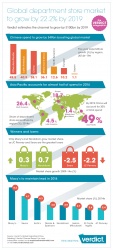The global department store market will grow by 22.2% in the five years to 2019, boosted by a 38.1% rise in spend in China, which will account for almost half of the $100bn incremental spend.
According to Verdict’s Global Department Store Retailing report, by 2019, 30% of all department store sales will be made in China, owing to rising affluence, increasing urbanisation and expansion opportunities for both domestic and overseas players.
Kate Ormrod, analyst at Verdict, says: “There are extensive growth opportunities in China; however, as overheads such as labour costs rise, we expect less profitable and weaker players to fall out of the market. Remaining players must further differentiate their offers through greater use of private label ranges, investment in instore environment and brand exclusives to drive footfall and sales.”
While the market shares of retailers operating in China and across South East Asia continue to rocket, shares of the leading global department store players have weakened over the last five years. Ormrod explains: “US player Sears has lost relevance in the US market, causing consumers to transfer spend to rivals, with a lack of investment in stores primarily to blame, particularly at a time when its competitors are doing the opposite. This has resulted in its share of the global market falling by 2.5 percentage points. Meanwhile, between 2009 and 2014, JC Penney has seen its share almost halve to 2.4%, due to a change in pricing structure and a proposition revamp. While it will take time to get shoppers back onside, it still has a clear place in the market and its initiatives – such as store refurbishments and its shop-in-shop concept – could bear fruit in the long term.”
Ormrod adds: “In contrast, Nordstrom's and Macy’s propositions stand out from the crowd, driving both sales and market share – the only two to do so in our top 12. Since overtaking Sears’ top position in 2012, Macy’s has increased its lead over its rival and is forecast to reach a 6.4% share in 2014, and while it has not been without its challenges, Macy’s product offer and store environment have been central to its success. Nordstrom’s continued investment in innovation and its decision to embrace multichannel has secured market share growth, and we expect it to remain a strong force in the US market in the coming five years.”
Source: Verdict










